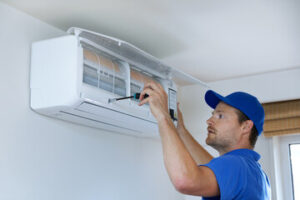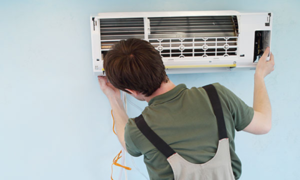Leaky ductwork can cost homeowners an inordinate amount of money in terms of energy bills. Having it repaired by a skilled contractor can help you cut costs and stay comfortable in your home. Contact HVAC Round Rock for professional help.

HVAC is an important factor in residential structures like single family homes, apartments, hotel rooms and sheltered accommodation; medium to large industrial and office buildings as well as skyscrapers. It is also present in vehicles like cars, trains, airplanes and ships.
If you have a HVAC system that needs repair, it’s important to consider the overall cost of the repairs. The total cost can add up quickly when you factor in labor and parts. Be sure to ask the technician to outline all of the costs before you approve them. Also, be sure to ask about the warranty coverage. It’s important to understand that some companies only offer a one-time warranty while others provide ongoing service.
If your HVAC unit is old and nearing the end of its lifespan, it may be more cost-effective to replace it than to invest in expensive repairs. Many units that are 10 to 15 years old experience frequent leaks and require expensive refrigerant recharging, making it more efficient to replace the entire unit than to continue with costly repairs.
Another consideration when considering replacing your HVAC unit is the size of the space that you need to heat or cool. A larger space will require a bigger system, which is more expensive to install and operate. You should also consider how much ductwork is needed for the new system.
Depending on the size of your home, you might choose to go with a packaged system that is housed in an outdoor unit. These systems are more cost-efficient than ductless mini-splits, but they can still cost more to install and maintain.
The type of system you select is a critical factor in your HVAC installation costs. A heat pump will cost more than an air handler, and a gas furnace will cost even more.
You should also take into account the climate where you live when choosing a new HVAC system. If you live in an area with a hot summer, you’ll need to invest in an AC with a higher SEER rating to keep your home comfortable.
A new HVAC system will need regular maintenance to keep it running efficiently. Without a regular tune-up, an HVAC system loses about 5% of its energy efficiency each year, which will increase your utility bills. To keep your home’s HVAC system in top shape, plan on spending $75 to $200 for annual maintenance.
Efficiency
When you’re looking for an HVAC system to provide comfort in your commercial building or home, efficiency is a major consideration. A good system conserves energy and lasts longer, lowering the overall cost of ownership. It also reduces waste and helps the environment by cutting down on emissions.
In general, the higher a system’s SEER or EER rating, the more efficient it is. You can also look for features like demand-controlled ventilation, which minimizes cooling and heating power consumption while providing occupants with adequate fresh air.
While the initial investment for a high-efficiency HVAC system is usually more expensive than an older unit, this difference will pay off in lower energy bills and fewer repairs over time. In addition, energy savings will help you meet sustainability goals and get closer to net-zero targets.
A streamlined HVAC system uses less energy and creates fewer emissions, which is vital in our eco-aware society. It also cuts down on operating costs and contributes to better budgeting. By reducing operating costs, you can spend more money on other important aspects of building operations.
HVAC equipment accounts for a large portion of energy usage in buildings, especially chillers and boilers. Optimizing HVAC systems to decrease energy usage without affecting indoor climate, temperature, humidity, and pressure levels is critical for effective facility management.
One of the biggest obstacles to achieving optimal energy efficiency is outdated equipment. The best way to improve the energy efficiency of your existing system is to upgrade it to a newer model with a higher SEER or EER rating. In addition, you can install new equipment with more energy-efficient design elements and controls.
Regular maintenance is another essential step to maximizing HVAC efficiency. Routine cleanings, refrigerant refills and lubrication of moving parts improve system performance, leading to reduced energy consumption. The maintenance team will also be able to spot potential problems before they become serious, which further reduces energy consumption.
Over operation is another significant cause of energy consumption. This can be caused by time schedules that are not accurately monitored or by manual overrides. By keeping time schedules and equipment parameters accurate, you can ensure that the equipment is working only when it’s needed and not wasting energy.
Installation
HVAC installation is the process of putting in place a heating, ventilation and air conditioning system in a building. This includes the installation of ductwork, registers and diffusers as well as the actual heating or cooling equipment. A qualified HVAC technician will also have the necessary training and certification to do a good job on the installation.
The first step in the installation process is to determine the size of the space that needs heating or cooling. This involves assessing factors such as square footage, design flow, and required tonnage. The contractor will then use this information to select the right equipment for the project. The contractor will also advise the homeowner on any energy efficiency or performance standards that should be met.
Next, the HVAC installer will prepare the site for work. They will lay down tarps and cardboard to protect floors and surfaces from dirt, dust, debris, and other contaminants that could get tracked in during the installation process. They will also mark off areas where they will need to cut holes in the walls and ceiling, if necessary. They will also take this opportunity to inspect the existing system and make note of any issues that need to be addressed during the install.
Once the ductwork and other components are in place, it is time to start piping in the new equipment. The Keller HVAC professional will connect the new system to the existing line set, if possible. They will then flush, clean and pressure test the lines to ensure they are ready for use.
If they cannot replace the existing line set, they will need to create a new one. This is usually not a problem, but it depends on the location of the new equipment and whether there are any obstacles in the way. In any case, the technicians will do a thorough inspection to be sure they are doing everything possible to get your new system up and running quickly and efficiently.
Once the installation is complete, the technician will test the thermostat and check the airflow to ensure that everything is working properly. They will also provide the homeowner with a maintenance manual and advice on how to keep the system running at its best.
Maintenance
A HVAC system is a major investment and requires proper maintenance to keep it running at peak performance. In addition to reducing energy costs, regular maintenance can extend the lifespan of the system by preventing wear and tear. Having a well-maintained HVAC system also helps to prevent sudden breakdowns, which are costly and inconvenient.
Routine HVAC maintenance includes cleaning or replacing the air filter, lubricating moving parts to reduce friction and improve efficiency, and inspecting the condensation drain for clogs that can lead to water damage in the home or commercial property. It also includes ensuring the thermostat is working properly and that all system controls are functioning as intended.
While a homeowner can perform some maintenance tasks, it’s best to leave the more involved repairs and inspections to professionals. An experienced technician can identify potential problems and repair them before they become serious. A professional can check the evaporator coil, ductwork, and cabinet (the outside “shell” of the system that holds all the inner parts together). The technician should listen for unusual noises when the system starts up and look for any suspicious or unusual odors. He or she should also move furniture, drapes, rugs, and other items that may be blocking the supply and return vents.
In addition, the technician should clean the exterior unit of the HVAC system, clip shrubbery, and remove any debris from around the unit. This is especially important if there’s been a recent storm or the unit was recently blown by strong winds. The evaporator coil is responsible for releasing heat into the air, and a dirty coil can reduce its effectiveness.
In addition, a HVAC technician can check the insulation and refrigerant levels to ensure that they are at appropriate levels. This is important because insufficient insulation can lead to an increase in energy consumption. Finally, the technician can check for electrical issues and repair them as needed. A faulty electrical wiring can cause a system to shut down and can also be dangerous for the home or business owner.
